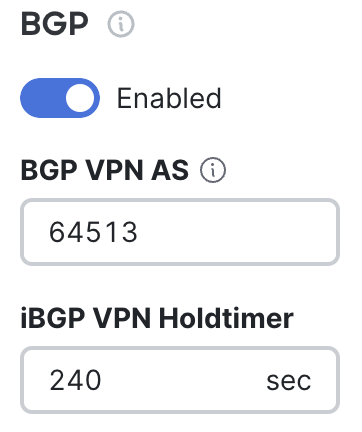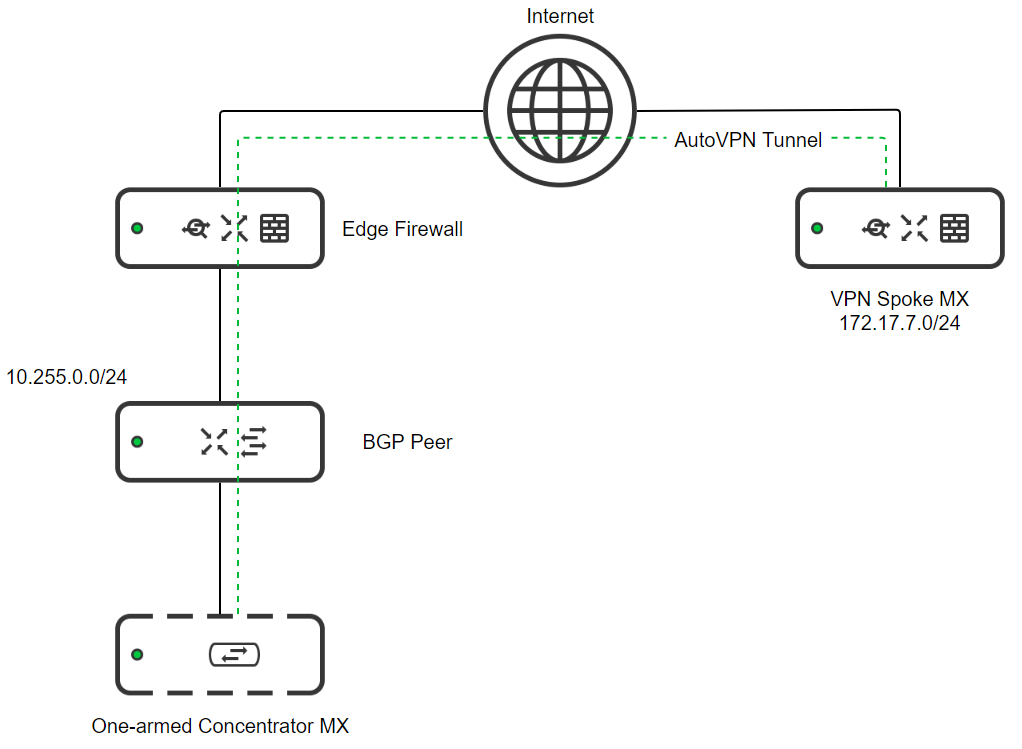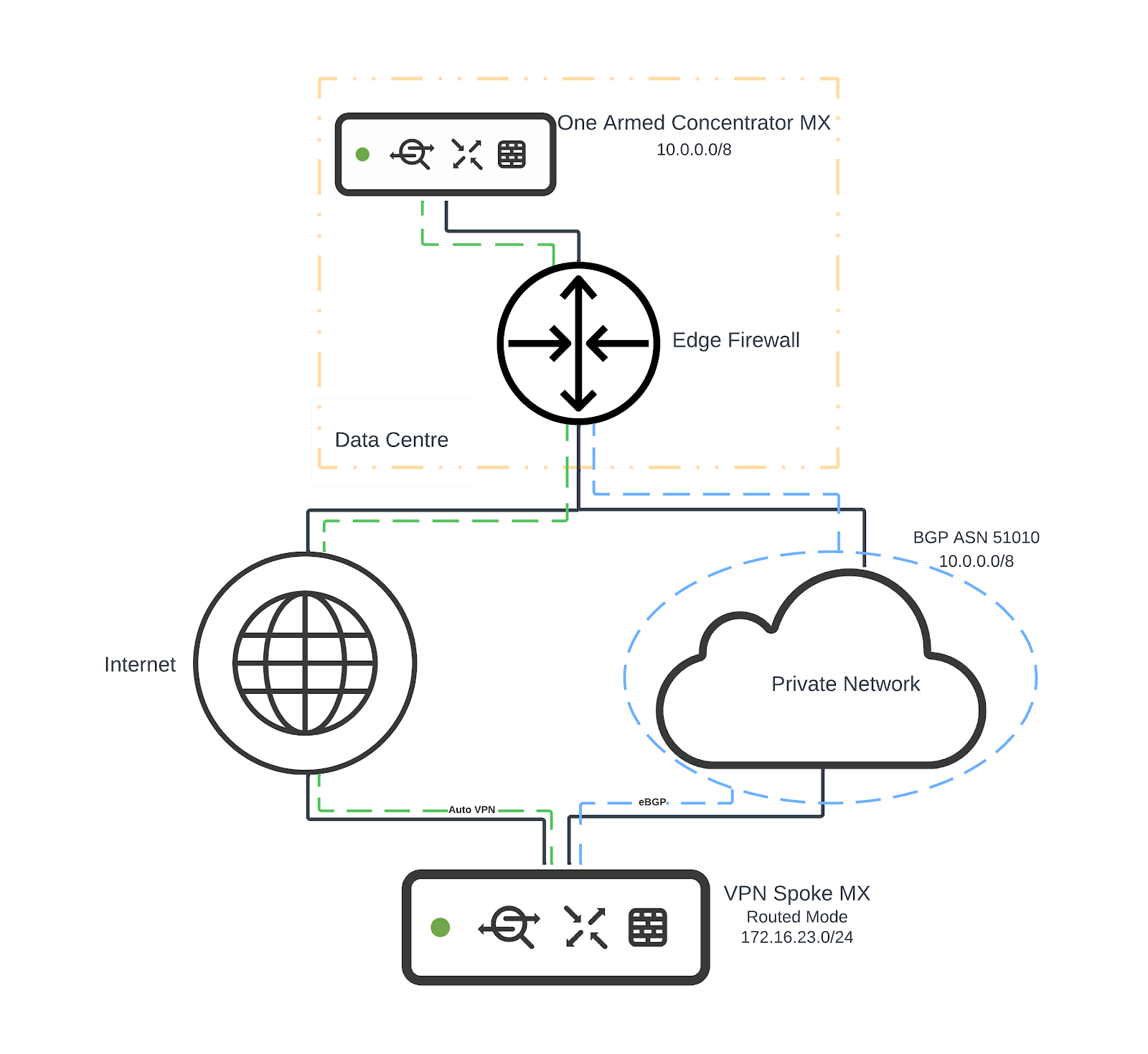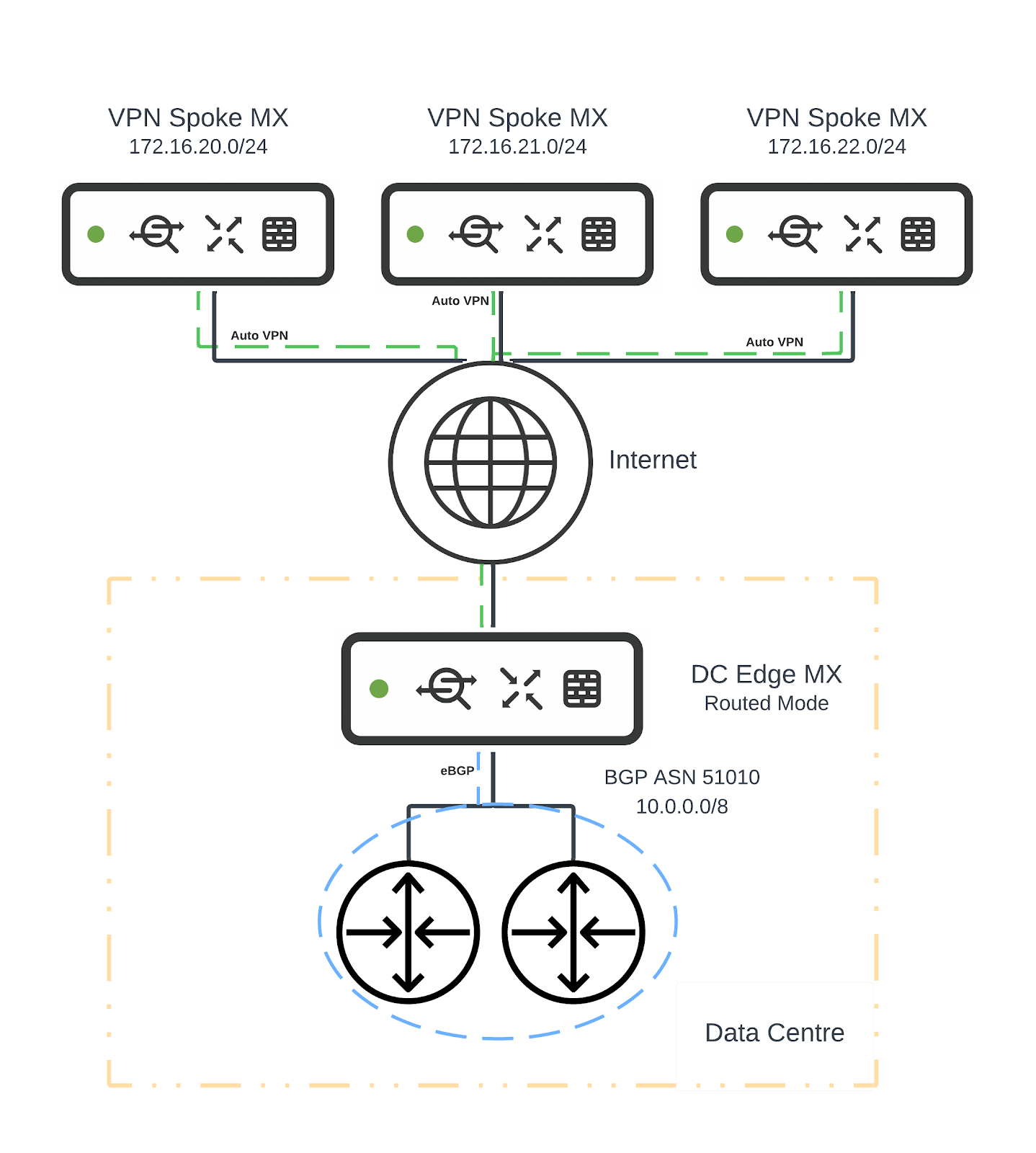Border Gateway Protocol (BGP)
Overview
All MX security appliances support the ability to communicate AutoVPN route information using BGP. This guide introduces key concepts, how BGP is implemented on MX appliances, and how to configure BGP.
- Mixed operation of MX14 and MX15/16 networks is NOT supported.
- BGP is not supported for template networks.
- IPv6 eBGP is currently only supported in One-Armed Concentrator mode.
- eBGP is supported for passthrough-mode hubs and routed-mode hubs running MX 18.207 or higher firmware.
- When establishing an eBGP peering on the WAN in routed mode, NAT must be disabled on that uplink (see NAT Exceptions with Manual Inbound Firewall) otherwise the subnets advertised by the MX will be behind NAT and unreachable via eBGP subnets upstream.
- eBGP is currently not supported on an uplink using PPPoE encapsulation.
Key Concepts
Understanding key concepts is essential before deploying BGP.
Deployment Mode
All MXs can be configured in either Routed or VPN concentrator mode. There are important considerations for both modes. For more detailed information on concentrator modes, click here.
One-Armed Concentrator
In this mode, the MX is configured with a single Ethernet connection to the upstream network. All traffic will be sent and received on this interface. This is the recommended configuration for MX appliances serving as VPN termination points into the datacenter.
Routed Mode
iBGP establishes relationships and exchanges routes over AutoVPN between AutoVPN peers.
eBGP peer relationships are supported on both the WAN and LAN of the MX, peering is bi-directional and routes will be automatically redistributed into AutoVPN.
VPN Topology
There are several options available for the structure of the VPN deployment.
Hub and Spoke
In a hub and spoke configuration, the MX security appliances at the branches and remote offices connect directly to specific MX appliances and will not form tunnels to other MX or Z-series devices in the organization. Communication between branch sites or remote offices is available through the configured VPN hubs. This is the recommended VPN topology for most deployments.
VPN Mesh
In a mesh configuration, an MX appliance at the branch or remote office is configured to connect directly to any other MXs in the organization that are also in mesh mode, as well as any spoke MXs that are configured to use it as a hub.
Datacenter Redundancy (DC-DC Failover)
Deploying one or more MXs to act as VPN concentrators in additional datacenters provides greater redundancy for critical network services. In a dual- or multi-datacenter configuration, identical subnets can be advertised from each datacenter with a VPN concentrator mode MX.
In a DC-DC failover design, a spoke site will form VPN tunnels to all VPN hubs that are configured for that site. For subnets that are unique to a particular hub, traffic will be routed directly to that hub so long as tunnels between the spoke and hub are established successfully. For subnets advertised from multiple hubs, spokes sites will send traffic to the highest priority hub that is reachable.
For information on configuring DC-DC Failover, please see this article.
Warm Spare (High Availability) for VPN concentrators
BGP Terminology
Border Gateway Protocol (BGP) is a highly scalable dynamic routing protocol that is used to exchange routing information between and within autonomous systems (AS).
Autonomous System (AS)
An autonomous system is a network, or group of networks, under a common administration and with common routing policies.
AS Path
The different autonomous systems traffic passes through to arrive at a specific router is its AS path. The AS path is a property of each route.
iBGP
If BGP is used to exchange routes within an autonomous system, then the protocol is referred to as Interior BGP (iBGP).
eBGP
When BGP is used between different autonomous systems, then the protocol is referred to as External BGP (eBGP).
Implementation
MX appliances use iBGP to exchange route information over Meraki AutoVPN. MXs deployed as one-armed VPN concentrator use eBGP to exchange and learn routes within the datacenter. Learned routes are redistributed to AutoVPN spokes using iBGP.
iBGP
BGP is configured on the Security & SD-WAN > Configure > Routing settings page. It is a requirement that the MX be participating in AutoVPN for BGP to be enabled. When BGP is toggled to enabled, the VPN BGP AS (this is an organization-wide setting) and iBGP Holdtimer can be set.

This AS number will be used for iBGP. Configuring this AS number will automatically set all other MXs in the organization to use the same AS number. Any change to the BGP VPN AS number applies to all MXs in the dashboard organization and will require them to fetch a new configuration.
Non-Meraki VPN tunnels will terminate when the VPN BGP AS is modified. These tunnels will reestablish once interesting traffic is generated through the VPN. Interesting traffic consists of any packet matching the local and remote IP address ranges defined by the VPN policy.
iBGP sessions are automatically established between MX appliances over their Meraki AutoVPN tunnels. It is important to note that iBGP is only established between MX devices within the same AutoVPN domain
eBGP
The Security & SD-WAN > Configure > Routing settings page can be used to configure eBGP neighbors when BGP is toggled to enabled.
To configure one, click "Add a BGP neighbor," then configure the Neighbor IP and Remote AS and Source Interface.

The eBGP neighbor must be configured to peer with the MX using the correlating interface IP and the organization-wide VPN BGP AS number.
Passthrough Mode eBGP multi-hop consideration
For passthrough mode eBGP multi-hop, this option is configured per neighbor. This value can be adjusted to peer the concentrator with something multiple hops away in the data center or cloud. If multihop is used AND the eBGP peer is also advertising the IP route that the MX is using to connect to the eBGP peer, 10.100.0.0/24 in the above example. Then this route MUST be added to the list of 'Local Networks' on the Security & SD-WAN -> VPN settings page, as shown below:

This is to avoid the more specific path to the eBGP peer being learned by the MX and then being lost in the event of the peer relationship dropping.
If the MX is deployed in a warm spare (high availability) configuration, the Virtual IP (VIP) will be used instead of the WAN IP address.
Default Update and Timeout Timers
The MX attempts to negotiate its hold time/update time at 240 seconds and its keep-alive time at 80 seconds. These timers get negotiated down to the lowest value between the pair, depending on what the other side of the eBGP pair has set. If the non-MX side of the pair is set for 180/60, the MX will negotiate down to 180/60. If the non-MX side is set for 300/100, the non-MX side will negotiate down to 240/80.
This value can be adjusted for faster failovers. For the iBGP VPN hold time the default as specified is 240. The configuration option on the concentrator site to site VPN page can be adjusted and this value applies to all Auto VPN peers we have iBGP connections to. The eBGP hold timer is configured per neighbor and can be more aggressive as it monitors a local link. When adjusting either value it is important to take into account load on the MX concentrator.
Platform Sizing Considerations
For Z3/c platforms we recommend only advertising a handful of aggregates or a default route to the datacenter. For the rest of the MX Security & SD-WAN appliances we recommend sizing the BGP topology to 1500 prefixes from the DC. This is because smaller appliances may also run other features such as Advanced Security, Meraki Insight, etc.
Route Table Integrity
To maintain route table integrity for all MXs in the Software-Defined Wide Area Network (SD-WAN) fabric, Meraki implements inbound and outbound protection from the MX. To protect the integrity of the route tables inbound, there is a configurable Receive limit. An Inbound filter is also available to restrict the routes learned to a pre-defined list of IPv4 prefixes, supported from MX 26.1.X firmware or greater. In addition to protecting the integrity inbound, there is also an AS Path ACL that is placed outbound for all eBGP peers. This AS Path ACL ensures that the Meraki ASN is always the originating ASN. This ensures that Merakis SD WAN fabric will never be transit between two DCs. This feature is enabled by default and can be disabled by clicking the checkbox under 'Allow transit'.
BGP Path Selection Attributes
eBGP attribute support by version:
- AS Path Prepend, MED and Weight require MX 19.1.4 or greater firmware.
- Outbound communities require MX26.1.1 or greater firmware.
Meraki provides the AS Path Prepend, Multi-Exit discriminator (MED) and Weight attributes to influence route propagation and path selection between autonomous systems. These optional attributes are applied per neighbor.
AS Path Prepending influences traffic inbound by artificially extending the as AS path length. When routes are advertised to a peer, additional AS numbers are appended to the existing AS path. As BGP prefers shorter AS paths when calculating the BGP best path algorithm, AS Path Prepending influences advertised routes to appear less or more desirable to a peer. The AS Path Prepend list supports up to 10, 4 byte unsigned, space-separated AS numbers.
Multi-Exit discriminator (MED) is used to influence traffic inbound by signaling a suggested entry point to a peer, When advertising routes to a peer an additional attribute value is included with the routes advertised. The med value is a 4 byte unsigned number, a lower MED value is preferred to a higher one.
Weight is a Cisco propriety metric used locally influence inbound route priority. As weight is locally significant, it is not advertised to external peers. As each MX can assign it's own weight to a peer, it gives the ability to influence the sites routing path to a common peer but not the entire AS. Weight is a value from 0 to 49 with a higher weight being a more preferred path.
Communities are used to group routes for applying routing policies, controlling route advertisement, and influencing path selection. A route can have multiple community attributes, and routers can add or modify these attributes before passing them on to peers. BGP Communities consist of four-octet values, either custom or well-known, configured as two colon separated numbers. The community attribute will be added on all routes advertised to the eBGP peer.
The following well-known predefined BGP communities are supported:
- Internet: Advertise the route to all BGP neighbors (default behavior).
- local-as: Do not advertise this route to eBGP peers (outside the local AS).
- no-advertise: Do not advertise the route to any BGP neighbor.
- no-export: Do not advertise the route to external BGP peers.
- blackhole: Indicates that traffic for this route should be discarded (blackholed).
- graceful-shutdown: Signals a BGP graceful shutdown (RFC 8326).
- no-peer: Do not advertise the route to route-reflector peers (RFC 3765).
Neighbor Security
Meraki offers two forms of neighbor security, TTL Security and MD5 password.
TTL Security
TTL security is a technique that verifies the legitimacy of BGP updates by using the Time-to-Live (TTL) field in IP packets. Administrators can modify the TTL value in BGP packets to verify if the packet has passed through the expected number of routers. The MX drops BGP updates with unexpected TTL values to prevent certain attacks.
MD5 Password
Message Digest5 (MD5) password in BGP authentication provides an additional layer of security by ensuring that only authorized peers can establish BGP sessions, reducing the risk of unauthorized route updates. With MD5 hashing, BGP routers exchange a hash value derived from a shared key during the session establishment process. This hash value is used to verify the authenticity of subsequent BGP messages exchanged between the routers.
Route Advertisement Behavior
Routes are advertised to eBGP and iBGP peers in the following conditions:
- A routed mode eBGP participant will learn routes advertised to it by other AutoVPN peers and re-advertise these iBGP learned routes to eBGP peers
- A routed mode eBGP participant will learn routes advertised to it by eBGP peers and re-advertise these eBGP learned routes to other AutoVPN peers via iBGP
- A VPN concentrator will advertise local networks which are not directly connected and are configured on the site-to-site VPN settings page via iBGP. These local networks will not be advertised via eBGP to external peers.. i.e. VPN concentrator will not advertise local networks via eBGP to external peers.
- A VPN concentrator will advertise local Client VPN/AnyConnect VPN networks via iBGP and eBGP to external peers as long as the subnets are VPN Mode 'Enabled' on the Site-to-Site VPN page.
Note: On routed mode MXs, the MX will only advertise those routes to its eBGP peer that are participating in AutoVPN. If a particular route on the Security & SD-WAN > Site to Site VPN page for any network has VPN mode set to “Disabled” this route will not be propagated via BGP. Static route redistribution is currently not supported on the MX platform.
The following scenarios will illustrate how routes are learned and advertised through both Internal and External BGP.
Note: On MX-Z devices, traffic for the following services and tools will adhere to the route priority outlined in our MX Routing Behavior article
-
Advanced Malware Protection registration
-
Meraki Cloud Authentication
-
Meraki Cloud Communication on TCP ports 80, 443, and 7734
-
Ping and Dashboard Throughput Live Tools
-
List Updates for the following services
-
Content Filtering
-
IDS/IPS Rule Updates
-
Geo-IP Lists for Layer 7 Country-Based Firewall Rules
-
Furthermore, if an MX is configured for eBGP and receives a route that overlaps with our cloud connectivity network ranges, the MX’s cloud management traffic will follow that BGP route, so it is imperative that the MX, as well as it’s eBGP peer, have connectivity to everything listed on the Help > Firewall Info page in this scenario.
Scenario 1: One-Armed Concentrator mode - Single iBGP and eBGP Peers
Consider the following topology:
- An MX configured as a one-armed VPN concentrator
- Another datacenter router with an established eBGP session with the one-armed concentrator
- A VPN spoke connected to the one-armed concentrator over AutoVPN. The two have an established iBGP session.
- 10.255.0.0/24 is a subnet that exists in the datacenter and is advertised over eBGP
- 172.17.7.0/24 is a subnet that exists in a remote branch and is advertised over iBGP

In this scenario:
- The One-armed Concentrator MX will learn 172.17.7.0/24 via iBGP from the VPN Spoke MX
- The One-armed Concentrator MX will learn 10.255.0.0/24 via eBGP from the BGP Peer
- The VPN Spoke MX will learn of 10.255.0.0/24 via iBGP from the One-armed Concentrator MX
- The BGP Peer will learn 172.17.7.0/24 via eBGP from the One-armed Concentrator MX
Scenario 2: One-Armed Concentrator mode - Multiple eBGP Peers
Consider the following topology:
- An MX configured as a one-armed VPN concentrator
- Two datacenter routers, "BGP Peer A" and "BGP Peer B" with established eBGP sessions with the one-armed VPN concentrator.
- A VPN spoke connected to the one-armed concentrator over AutoVPN. The two have an established iBGP session.
- 10.255.0.0/24 is a subnet that exists in the datacenter and is advertised over eBGP through BGP peer A
- 192.168.4.0/24 is a subnet that exists in the datacenter and is advertised over eBGP through BGP peer B
- 172.17.7.0/24 is a subnet that exists in a remote branch and is advertised over iBGP

In this scenario:
- The One-armed Concentrator MX will learn 172.17.7.0/24 via iBGP from the VPN Spoke MX
- The One-armed Concentrator MX will learn 10.255.0.0/24 via eBGP from the BGP Peer A
- The One-armed Concentrator MX will learn 192.168.4.0/24 via eBGP from BGP Peer B
- The VPN Spoke MX will learn of 10.255.0.0/24 and 192.168.4.0/24 via iBGP from the One-armed Concentrator MX
- Both BGP Peer A and BGP Peer B will learn 172.17.7.0/24 via eBGP from the One-armed Concentrator MX
- BGP Peer A will also learn 192.168.4.0/24 from its eBGP session with the One-armed Concentrator MX
- BGP Peer B will also learn 10.255.0.0/24 from its eBGP session with the One-armed Concentrator MX
Scenario 3: One-Armed Concentrator mode - Datacenter Redundancy (DC-DC Failover)
Consider the following topology:
- A VPN Spoke with a local subnet of 172.17.7.0/24
- Two datacenters set up with a DC-DC Failover configuration:
- The VPN Spoke MX establishes VPN tunnels to a one-armed VPN Concentrator in each datacenter
- The same subnet is advertised to the spoke through both datacenters
- Communication to the datacenters is an active/passive failover configuration.
- The active hub is defined based on its configured hub priority. The one-armed concentrator in the primary datacenter has the highest priority in this scenario.
- If the VPN Spoke MX were configured in a VPN mesh configuration, the organization-wide VPN concentrator priority would act as the hub priority in this case.
- The active hub is defined based on its configured hub priority. The one-armed concentrator in the primary datacenter has the highest priority in this scenario.
- The primary datacenter has subnets of 10.0.0.0/8 and 192.168.80.0/24
- The primary datacenter has an ASN of 1111
- The one-armed VPN concentrator in the Primary datacenter has an active eBGP session with BGP Peer A
- The secondary datacenter has subnets of 10.0.0.0/8 and 192.168.1.0/24
- The secondary datacenter has an ASN of 2222
- The one-armed VPN concentrator in the Secondary datacenter has an active eBGP session with BGP Peer B
- The VPN Spoke MX is connected to the one-armed VPN Concentrator MXs in both datacenters. There are active iBGP sessions between the spoke MX and both concentrators.
- The organization-wide AutoVPN ASN is 8888
.png?revision=1&size=bestfit&width=751&height=649)
In this scenario:
Primary DC
- The One-armed Concentrator MX will learn 10.0.0.0/8 and 192.168.80.0/24 via eBGP from BGP Peer A.
- The One-armed Concentrator MX will learn 172.17.7.0/24 via iBGP from the VPN Spoke MX.
- BGP Peer A will learn 172.17.7.0/24 via eBGP from the One-armed Concentrator MX
Secondary DC
- The One-armed Concentrator MX will learn 10.0.0.0/8 and 192.168.1.0/24 via eBGP from BGP Peer B.
- The One-armed Concentrator MX will learn 172.17.7.0/24 via iBGP from the VPN Spoke MX.
- Routes learned from the VPN Spoke MX by the One-armed Concentrator MX in the secondary DC will have an additional ASN (8888) pre-pended
- BGP Peer B will learn 172.17.7.0/24 via eBGP from the One-armed Concentrator MX
- Routes that are learned via iBGP by the One-armed VPN Concentrator in the secondary DC and re-advertised via eBGP will have an AS Path of 8888 8888
VPN Spoke
- The VPN Spoke MX will learn 10.0.0.0/8 and 192.168.80.0/24 from the primary One-armed Concentrator MX
- The VPN Spoke MX will learn 10.0.0.0/8 and 192.168.1.0/24 from the secondary One-armed Concentrator MX
- The 10.0.0/8 route was learned from two different sources. Since the One-armed Concentrator MX in the secondary datacenter has a lower hub priority, the 10.0.0.0/8 route learned from the primary is preferred
- This path preference is achieved via AS path pre-pending, this means that:
- Routes from the primary One-armed Concentrator MX will have an AS path of 8888
- Routes from the secondary One-armed Concentrator MX will have a less desirable AS path of 8888 8888 and the primary route will be preferred
- This pattern continues for any additional hubs
Scenario 4: Routed mode - eBGP peer on WAN of spoke
Consider the following topology:
- VPN Spoke MX is configured in No-NAT routed mode.
- VPN Spoke MX site is a site with both direct internet access and private network backhaul.
- VPN Spoke MX and DC edge both have an eBGP peering with a service provider.

In this scenario:
- VPN Spoke MX will learn 10.0.0.0/8 via iBGP from One Armed Concentrator MX
- VPN Spoke MX will learn 10.0.0.0/8 via eBGP from eBGP peer AS 51010
- One Armed Concentrator MX will learn 172.16.23.0/24 via iBGP from VPN Spoke MX
NOTE: If an uplink goes into a failed state because its Internet connectivity checks for WAN failover stop passing, MX devices will continue to use any eBGP-learned routes over the uplink in question if they still have connectivity to the peer advertising them. This is done under the assumption that they are still valid routes if the peer has not withdrawn them.
Scenario 5: Routed mode - eBGP peer on LAN
Consider the following topology:
- DC Edge MX has 3x VPN spoke MXs
- DC Edge MX has an eBGP peering with downstream network.

In this scenario:
- DC Edge MX will learn 10.0.0.0/8 via eBGP from eBGP peer AS 51010
- eBGP peer AS 51010 will learn 172.16.20.0/24, 172.16.21.0/24 and 172.16.22.0/24 via eBGP from DC Edge MX
- VPN Spoke MXs will learn 10.0.0.0/8 via iBGP from DC Edge MX

